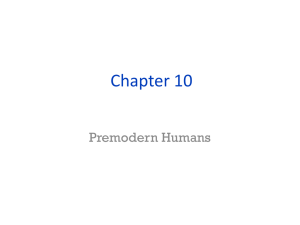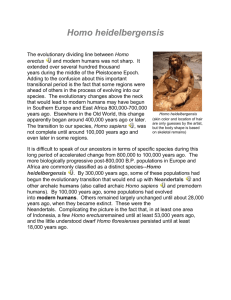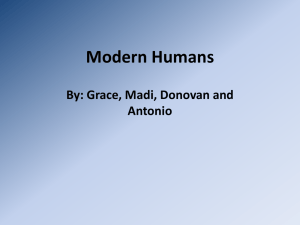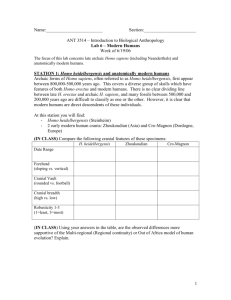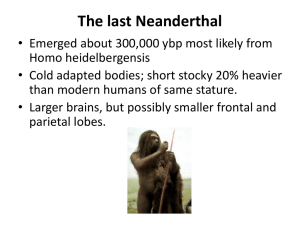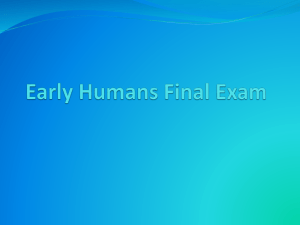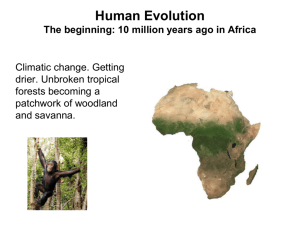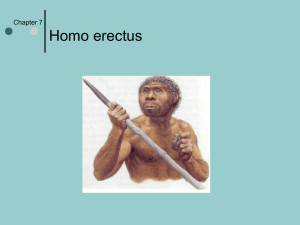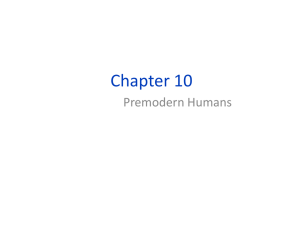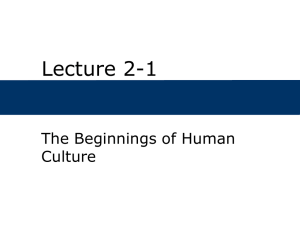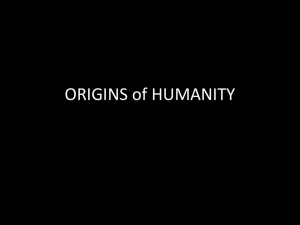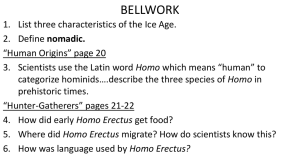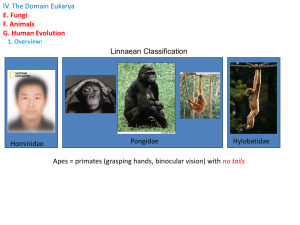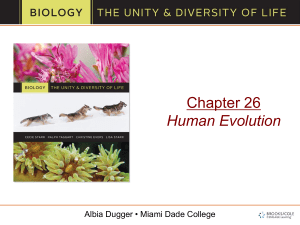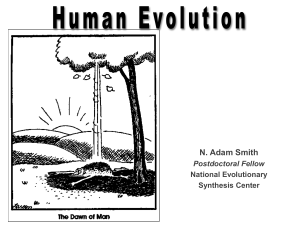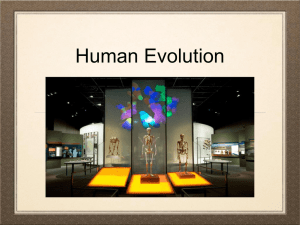Homo Heidelbergensis and the Beginnings of Modern Thinking
advertisement
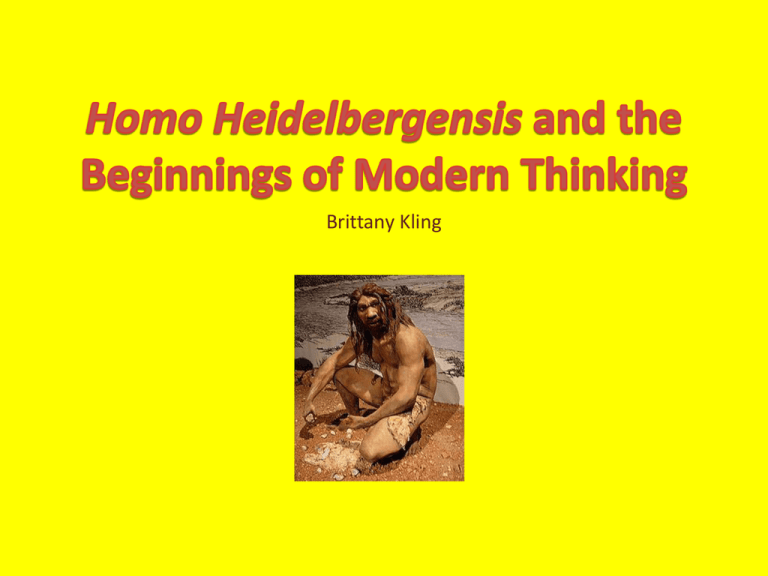
Brittany Kling Remains of Four Spears found in Schoningen, Germany • These spears were created by using stone tools to sharpen both ends of 2-meter long spruce shafts that had been scraped smooth. • Associated with carcasses of horses- It appears the users of these spears were hunters. • Almost 400,000 years old! The oldest reliably identified weapons ever discovered! • Production required a series of routines and sub-routines that were more complex than those for hand-axes Pleistocene Climate Change • The Pleistocene is the epoch from 2.588 million to 12,000 years BC covering the world's recent period of repeated glaciations. • Glaciation in the Pleistocene was a series of glacials and interglacials, stadials and interstadials, mirroring periodic changes in climate. The main factor at work in climate cycling is now believed to be Milankovitch cycles. These are periodic variations in regional solar radiation caused by the sum of many repeating changes in the Earth's motion. • Homo erectus came to be successful within this rapidly changing context. We think that their ability to adapt is due to their cognitive adaptations. Brain Size and Brain Shape • Rightmire, the authority on Middle Pleistocene hominins, places pre-modern Homo into two groups: 1. Homo erectus in Africa, Europe, and East AsiaBrain size evolved, but very slowly. 2. Homo heidelbergensis in Northern Europelarger cranial capacity and EQ, some had brain sizes close to the modern average! (Northern Europe-where the climatic swings of the Pleistocene were most dramatic along with severe environmental consequences. Technique • Intro of soft hammers made of wood, bone, or antler – When a knapper uses a soft hammer, flakes are produced that are thinner and sharper. • Development of platform preparation – The knapper removed a number of small flakes from a core edge, or crushed the core edge, or ground the core edge in order to increase the control of the knapping blow. – Over time, the variety of flake tools increased, and the number of hand axes declined. Refinement • • • • • • • • “Bifaces became prettier over time!” Three dimensional symmetry Plan, profile, and cross-secton Symmetry more precise Edges more linear in profile Thinning of the bifaces produced beautiful artifacts. Could produce twisted or “bent” plan shapes Development of refinement appears to be gradual.This fine-tuning could cause a selection for appropriate cognitive abilities. Two Methods of Investigation: Refitting and Experimental Replication • Experimental Replication- Modern stone knapper attempts to reconstruct the actions necessary to produce a particular kind of flake or core – Same products can result from different procedures • Refitting- Archeologists refit flakes – Very tedious • Very useful in cognitive analysis Controlled Fire and Built Shelters • Hearths found at the German site of Bilzinsleben, and the French sites of Terra Amata and Lazaret • Terra Amata and Lazaret-evidence of possible huts in the form of post molds • Lazaret-internal pattern of remains that also suggests an enclosure (controversial- not as coherent as some have suggested) • This suggests that the technology of Homo heidelbergensis extended beyond stone tools to include materials and knowledge in order to deal with the cold in these higher latitude areas. Landscape Use • Hominins took hand axes with them from horse remains, but discarded of them by a water-hole, a permanent landscape to which they returned. • The overall pattern of temporary and re-used locales indicates that Homo heidelbergensis had a structured approach to landscape use, and repeated habitual patters of action again and again.-regular and predictable patterns Symbols Berekhat Ram Object • Scratches produced by a stone tool • Some consider this an iconic image of a woman. • 2.5 cm Mineral Pigments • The range of colors evident at Twin Rivers (red, yellow, brown, black and purple) and the effort expended when easier pigments were at hand suggest hominins were interested in the colors themselves. Spatial Cognition • Allocentric perception-the ability to imagine points of view not centered on one’s own view – To make a three-dimensional symmetry the knapper needed to control the shape of the artifact from many different angles and perspectives, some of which were not directly sighted. • Spatial quantity-size is coordinate with shape-recognition abilities in order to get congruent symmetry in hand axes – Requires a more sophisticated coordination of the dorsal and ventral pathways of visual processing • Homo heidelbergensis may have been the first to have understood space in this way, and used this intuition to guide and control their actions. • The ability to maintain and manipulate images and spatial relations demonstrates usage of the visuospatial sketchpad. Technical cognition • The authors suggest homo heidelbergensis were able to hold more info, and this increased capacity had both a long-term component (more procedures) and a working memory component, which in turn included developments in the visuospatial sketchpad and attention. Symbolic Thinking • Evidence of pigment at Twin Rivers required several actions of hominans. • Invested more effort in had axe production than was necessary for its mechanical function. Language • Endocast of the Kabwe Homo heidelbergensis cranium is well within the modern range in terms of size • Demonstrates a modern patter of left occipital and right frontal petalias, and the left ventral premotor cortex (Broca’s area) is enlarged relative to the right • Basicranium is more angled, a feature that has been linked to lengthening of the pharynx • Diameter of the hypoglossal canal is in modern range (passage in cranial base through which pass the nerves that enervate the tongue)-enlarged canal suggest greater control of tongue Cognitive Developments that distinguished Homo heidelbergensis from Homo Erectus • Spatial cognition with allocentric perception and coordination of spatial quantity and shape recognition • Technical cognition with longer, more hierarchally organized procedural routines • Shared attention, required for technical learning • Ability to maintain two goals simultaneously (suggests a possible increase in working memory capacity) • Attentive use of indexical signaling The End!

